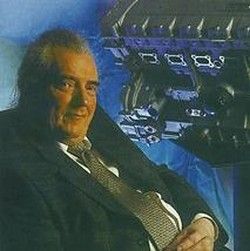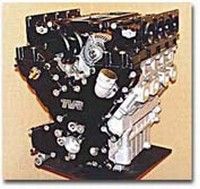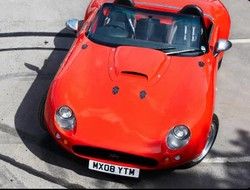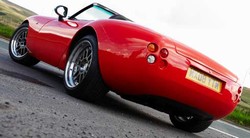Al Melling Interview
Engine guru Al Melling tells PistonHeads what went wrong with TVR, why the Tesla has no future and why the AJP8 is so iconic...
Can you tell us a little about the new Wildcat – what will make people want to buy it?
The Wildcat is designed as a very simple car. It has always been my opinion that a car should be a rolling chassis that is stiff enough to drive on its own, without the strength of a body. Therefore the body on the Wildcat is just panels, which is also great for any kind of damage as they can be repaired very easily. When the body panels are removed, which takes an hour, there is total access to all parts, even without getting underneath the car.
The other point about the Wildcat is that we have a basic design on which the purchaser can almost build his own car. Aircon, a CD player and a variety of colours can all be chosen. With regard to the engine and transmission, there is an option to have the Chrysler Hemi with 426bhp to 680bhp, the Chrysler SRT10, the BMW V8, the Mercedes V12 or the Al Melling 5-litre V8. There is an option for Ford V6, in which interest is being shown by lady drivers. We have managed to do this and keep the cost between £39,995 and £49,999.
You are quoted as describing the Wildcat as 'the car the TVR Griffith should have been' - what went wrong with the Griff?
The TVR Griffith at the time, as shown by its sales, was acceptable, but these days sports cars must have some kind of durability and in-built safety in the design. These are the points with regard to updating the Griff. The Wildcat is completely different, the Wildcat is a completely new car and of course it includes rear crash structure and crumple zones, and also proper side impact protection.
With regard to other points of design of the Griff, and in fact with most TVR models, the inner wings took a lot of volume from the engine bay. For example a Griff or even a Cerbera fitted with the AJP8 has got restricted space for the intake system. If the inner wings were 200mm wider across the car, an extra 60bhp could be gained from a 4.2 AJP8.
"TVRs are quite complicated and not easy to build, that is one of the reasons why TVR was insolvent at the end. It is my opinion that to resurrect the cars is impossible."
Regarding the six cylinder engine, this was designed on its side, purely and simply to get the exhaust primaries to miss the top rail of the chassis. It does not give a lower bonnet height, and of course the top chassis rails are in line with the inner wings. The points mentioned here are purely and simply that the car evolved as opposed to being a new design model. So for example a Chimera, a Cerbera, even a Sagaris and a T350, all came from a 3000S, which obviously was a very old design concept.
Do you think the TVR brand has had its day, or is this just a temporary lull in a long history to come?
This is a question that is put to me on a daily basis. As you probably recall, during the closed auction of TVR, it concluded with only two bidders. One was Mr Smolenski and the other was myself. When you get into this situation in a business deal, obviously a lot of information, such as the last four years of accounts, inspection of all the tooling, and inspection of inventory, all become part of a due diligence. With this in mind and the consideration of the design of the TVR range over the previous seven years, we feel fairly qualified to give an opinion.
All the tooling is fragmented and in different places, and of course TVR did not have any kind of engineering company systems and logistics, therefore a lot of the information for building cars was in the heads of most of the employees. Thus to set up again and start making these cars is almost impossible in my opinion. When we considered buying the company, we envisaged that it would cost a minimum of £12,000,000 and at least two years to get even a small volume of production.
The cars are quite complicated and not easy to build, that is one of the reasons why TVR was insolvent at the end. It is my opinion that to resurrect the cars is impossible. But with regard to the brand, I think with the correctly designed car and the right marketing then I don't see a problem with the brand going forward. But in my opinion, if things go on as they are, Mr Smolenski will only have the brand for his mantelpiece.
What qualities should a good sports car have? And what makes a good engine?
In my opinion a good sports car should be a car with good handling, open or closed top, make the right noises, and look good especially from a classical point of view from the days of 'wind in the hair' sports cars. A number of modern sports cars, with slots, wings and grooves are not sports cars, they are pseudo race cars. Regarding the engine, the engine should be bullet proof and horsepower and torque should be almost equal. It should be that when you strap yourself in and you press the start button you are mindful that you are about to embark down the Mulsanne straight.
I think that a sports car comparison should be to a sports aeroplane, or a sports boat, the instrumentation is there for what's going on, not for carrying cups of coffee, not for the latest CD album, and not to keep you warm. A properly designed sport car, keeps you warm, from its in built heater - the engine - and it shouldn't need a rear screen on open top cars. If it’s designed properly the wind should impede way behind the occupant’s heads.
What is your favourite engine of all time?
I have been an engine designer for 40 years and I would like to think that I have not yet met my favourite engine. Engines are designed with a particular application in mind; for example a Formula 1 engine is for F1, it would be no use for anything else. Regarding sports car engines do we consider exotic, complicated, durability or do we just consider power? If we take the AJP8, it is a very simple engine, but it has the highest power to weight ratio of any engine yet designed ( 4.18bhp per Kg). It also has probably the highest torque per litre (114 ft/lbs) and of course it was proved in Tuscan racing where some of the engines were only rebuilt after three years.
I have lots of favourites, it is extremely difficult to answer your question without sounding as though I am advocating my own designs, but in my opinion the most awesome sounding engine would be the racing Silk Cut Jaguars that I did for TWR, and of course the Norton Nemesis. Check these out I think you will agree. The most beautiful looking engine has got to be the Hellcat V10 or the 1960's Racing Mondial single cylinder racer. From a point of view of usage, the Suzuki inline 4 as fitted to the Bandit, does everything, wins races, wins drag races and is fitted to the best touring bike ever.
What is the status of your involvement with Formula One?
I have been a consultant in Formula for the past 23 years, but now I am winding down on that and concentrating on our car projects.
What do you think made the AJP8 so iconic?
The AJP8 was designed to fit the TVR cars, which in my opinion was totally wrong. At the beginning we informed TVR the power that the engine would have, and it was obvious they never believed us. The specification of the engine was completed by myself around a design that could produce sales for the engine and the car, therefore it was put forward to TVR that the design of the engine would be capable of being a stressed member in a single-seater car, and also be used as a road car.
The idea was that sales of the engines would provide a big income from the racing fraternity. At no time was TVR willing to modify any part of the car for the engine, therefore a 90 degree V8 four-valve would be impossible to fit in the car, bearing in mind, the Rover was a pushrod, which utilises very small cylinder heads. I considered that the best V angle would be 75 degrees.
Utilising the single cam technology that I had used on the V12 Jaguars and also utilising a flat plane crank the engine would have good power, rev out capability and a good torque curve. Due to envisaging the use of the engine in a single seater race car, the engine would run in a vacuum, crankcase-wise, to give good oil control. When the engine was built and first run on the dyno it produced the power that I had advocated and Peter Wheeler immediately stated that they did not have a car to put it in. Therefore it was decided to build a new car, which was the Cerbera.
If you were designing it again now, would you do anything differently?
I wouldn’t do anything different to the existing design, other than scrap the wet sump versions, that we were pressured into designing. The engine is powerful, robust, very reliable and with the new emission modifications by MCD. The engine has got a long life.
What are some of the more interesting things that MCD has consulted for recently?
Over the past 40 years, MCD's work amounts to approximately 60% complete engine design, 30% consultancy work, and 10% expert witness in court case work, involved with the automotive industry. Most design contracts are usually two, three or maybe four years duration. If it’s a new engine for example, it carries a very serious confidentiality agreement, therefore any information prior to that is usually not possible.
We can inform you that over the past five years we have completed a range of V-Twin engines for an American motorcycle manufacturer. We have just completed a new V10 engine, four-valve, twin cam, with approximately 600bhp, for a European manufacturer and a 5-litre V8, for a European manufacturer. Our present contracts include a single cylinder desmodromic, 6-speed motorcycle engine unit, for a European manufacturer, and a V16 supercar engine for a European manufacturer.
Do you agree with the current vogue for forced induction on all engines?
The reason for using forced induction on modern engines is not a 'vogue'. The reason for using forced induction is to help the engine pass the 08 type approval regulations. On a normally aspirated engine, to get the power the design of the camshaft must include an amount of valve overlap. At this point in the engine cycle, raw fuel is passed from the induction, through the exhaust port, which gives high hydrocarbon and CO2 levels.
If certain things are considered in the design of the engine, for example the valve angles and port angles, and are designed correctly for that particular concept, then it is possible to reduce this effect somewhat. On other normally aspirated engines, it is possible to reduce the emissions in the exhaust port by fitting air injection for example. Like the Corvette engine.
On other engines, especially smaller engines, then it would not be possible to get the power with valve overlap, therefore to get good cylinder filling, it is much easier to turbocharge or supercharge the engine and remove the valve overlap as much as possible on the camshaft. This also makes it possible to use a lower compression ratio, which results in better running and fuel economy.
Where does the future of the sportscar market lay - do you see it in cars like the Tesla Roadster, or more traditional lightweight sportscars - or something that we haven't even thought of?
You mention the Tesla, but I'm afraid I don’t think it’s got any future. I don't see that somebody will buy a car at that price that's capable of doing 200 or less miles and then having to wait 12 hours to fill the fuel tank. In my opinion as a professional engineer there is nowhere in any of the engineering institutions of the world that believe battery traction has got a future except in utility vehicles.
Regarding track day cars, this is a new industry that has come out, and I think it’s got a big future. This is proving not only in cars, but also in bikes, and I think that this is here to stay as a new sport.
Will the sports car market recover after the global economic slowdown, or do you think some permanent scars will be left?
In my business I have to believe that the sports car market will go on. Over the years there have been ups and downs, the muscle cars in the states in the ‘70s were ousted but since 2000 muscle cars are now sought after. There will always be the guy who wants a beautiful sports car and the engineering that goes with it. There will also always be the guy who wants one to have one.
this is based on total weight being 121KG's (according to TVR), somewhat un-belivable etc.

Really interesting article though.
You have a filter-box at the front of the car with large-diameter (I'm gonna call them) secondary pipes feeding a pair of airboxes which in turn feed each bank of cylinders through (again, my terminology) primary pipework.
Basically the standard primary pipework looks like a pair of hands with interleaved fingers. The RHS airbox feeds the LHS bank of cylinders and vice versa.
By reducing the lengths of the "fingers" such that the LHS airbox feeds the LHS cylinder bank, it has been proven that you move the torque UP the rev range. Then, as
bhp = (torque x revs)/5252
... you end up with more power (same torque but at higher revs).
This is all well-known in the Cerb tuning world, but owing to lack of space only a little experimentation has been done regarding the lengths of the secondary pipework (from the front filter-box to each of the airboxes). I understand that to significantly improve on the power available, you need significantly longer pipes here.
I'm guessing that Melling's comment might involve larger airboxes and that the effect of larger airboxes might be the same as increasing the secondary pipework lengths.
Just a guess.
Having said that he specifically mentioned the 4.2 V8 which, as things stand, is pretty much impossible to improve upon the (roughly) 360bhp they already gve.
Interesting article though.
Interesting article though.
Gassing Station | General Gassing | Top of Page | What's New | My Stuff











